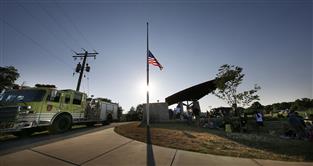The public hiring landscape has changed, and the constant tension between paying enough to keep valuable employees and controlling city costs is requiring innovations, City Administrator James Archambo said.
A new pay structure, a job market that for some positions has the public and private spheres competing against each other, and what Archambo views as the changed needs and expectations of the millenial generation, have motivated the city to consider new methods of recruitment and retention.
Behind it all is the state's Act 10, the 2011 law reducing public employee bargaining power, and the Affordable Care Act, which to a degree is disentangling the relationship between employment and health care, improving employee mobility.
For municipalities statewide, "it is virtually an out-of-body experience," said Charles Carlson, a consultant who helped Wauwatosa create its new pay plan.
Public vs. private
"We are looking more like the private sector," Archambo said.
In years past, "for some of our positions, we were essentially able to just go to other municipalities and compete for the same pool of workers. And now we're competing in a much larger pool that includes, to a greater extent ... the public sector as well as the private sector."
The city's new pay structure, which includes an element of merit pay, is an attempt to meet or slightly exceed market rates for the city's many positions.
Looking at a new, market-based pay rate — which in virtually every case met or exceeded the employee's previous rate — some city workers were prompted to re-evaluate themselves and look around, Archambo said.
"It appears that we are seeing at least more people leaving for other employment than we have in the past," Archambo said. "My only caution is that, from a numbers standpoint, it may be a fluke."
Last year, 39 employees departed, including 22 retirements. Both numbers were the highest since 2010, when the public employment environment was in upheaval. That year, 27 retired and 16 resigned, a total of 43.
Retirement vs. retirement
There are retirements — people who are done working — and then there are retirements — people who might've stayed longer in an unchanged environment.
"I don't know with certainty. I suspect that there is some of that going on, where, if they had a multiple-year window of retirement, they may be leaving on the front end as opposed to the back end," Archambo said.
Truck drivers, laborers, secretaries, accountants and others are as employable in the public environment as in the private. Among professional classes, engineers and especially information technology specialists could likely find work in either sector.
"What it boils down to is we have to be more flexible and mindful of what the market is," Archambo said.
Protections in public work
Carlson, with 40 years in the field, said that while the public-sector job market is no longer isolated from the private sector, public employees still generally are benefited by seniority and have more job security. Though most union privileges are gone, employment law has more protections for public workers, he said.
"It is still a highly regulated environment," he said.
The millenial character
Hiring, like retention, also presents new challenges, Archambo said.
The city's new compensation plan is more flexible than what it replaced. For example, to attract somebody in mid-career, the city may match the new hire's previous weeks of vacation, rather than make him or her start at the bottom of the scale.
But young people new to the job market want different things than their predecessors, Archambo said.
"We can't assume that the same benefit package or benefit structure that has worked in the past ... is necessarily what is going to work in the future, because many employees we are finding — and there's a lot of literature that talks about, particularly, millenials — are looking for very different things," he said.
Pro and con
Archambo said they aren't necessarily assuming they will stay with the city for an entire career; they care less about, say, retirement packages; and "they're not expecting to be here that long." He sees a greater desire for flexible schedules, more time off, project-driven work and the desire for a sense of "ownership" of a realm of work as characteristics of newer entries to the work force.
Carlson, however, has a different take. It's not about this generation, he said.
"My experience is that newer employees, younger employees, typically are more focused on take-home pay, because they need the money — you know, they're starting their jobs, they don't make that much, et cetera — and benefits aren't as critical. They're healthier."
When they have kids, when their health is vulnerable, when they face retirement, that's when they care about benefits, he said.
Archambo said the most important characteristic of a potential recruit is "that they have a genuine interest of serving the public. You want the person that wants to, not just do a job, they want to fulfill a mission."
Wauwatosa employee turnover
2007
Year
Retirements
Resignations
12
16
2008
14
19
2009
6
17
2010
27
16
2011
15
22
2012
16
15
2013
22
17
More from News and Features
- Anodyne Coffee plans to open location in Wauwatosa Village
- Wauwatosa Meetings: Aug. 4
- Video: Wauwatosa girl's curbside ice cream stand raises money for the hungry
- Wauwatosa News and Notes: Hands-only CPR training offered; Firefly Art Fair is Aug. 6-7
- Wauwatosa Ask Now: Why are there barriers and fencing along the North Avenue bridges over the Menomonee River?
- Mystery Photo Contest: July 28
- Wauwatosa gears up for National Night Out event, this year at the zoo
- Election 2016: Wisconsin's 4th District candidates weigh in
- Wauwatosa's Luther Manor residents share smiles through flower delivery
- Wauwatosa Police Report: July 17-23














